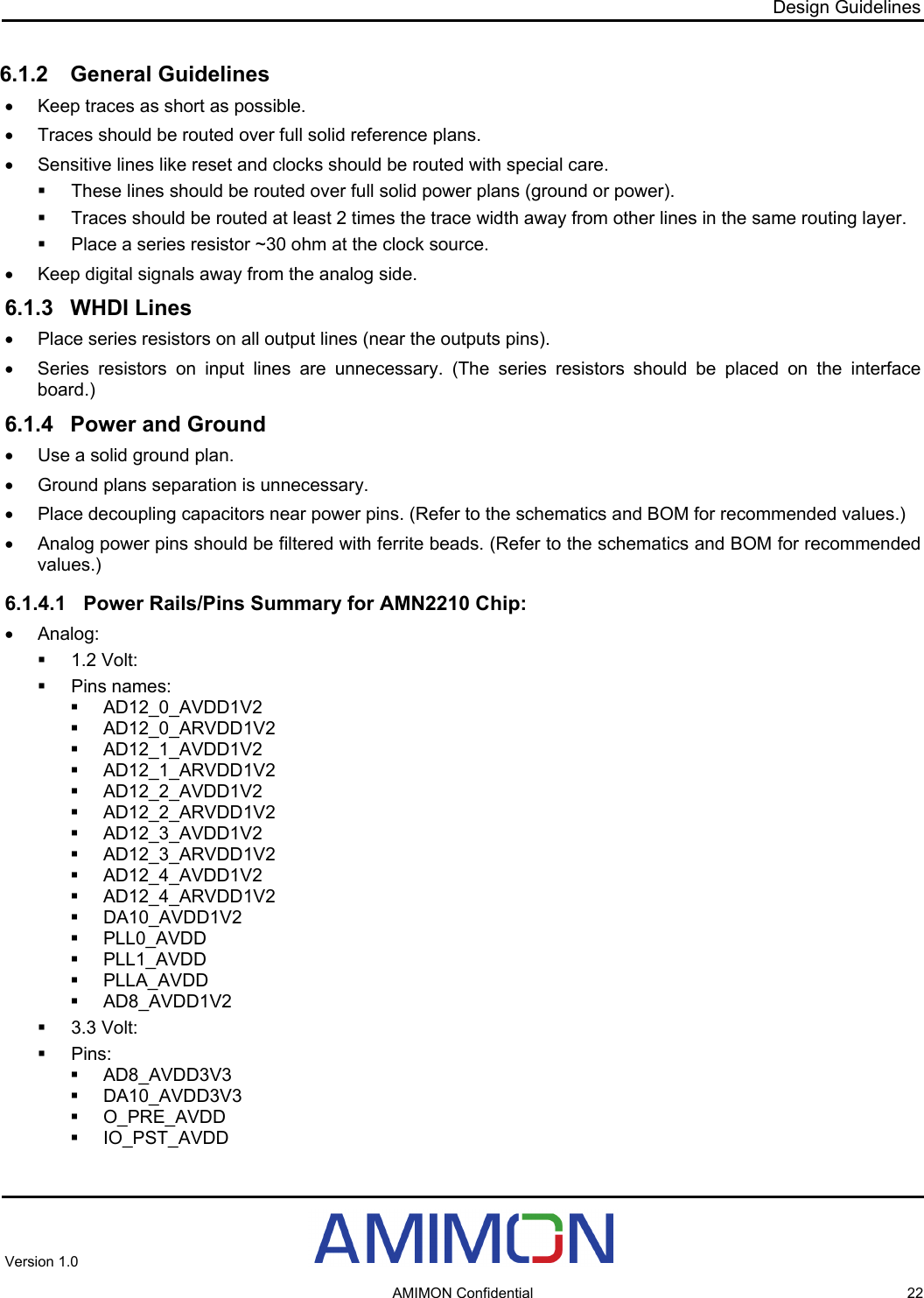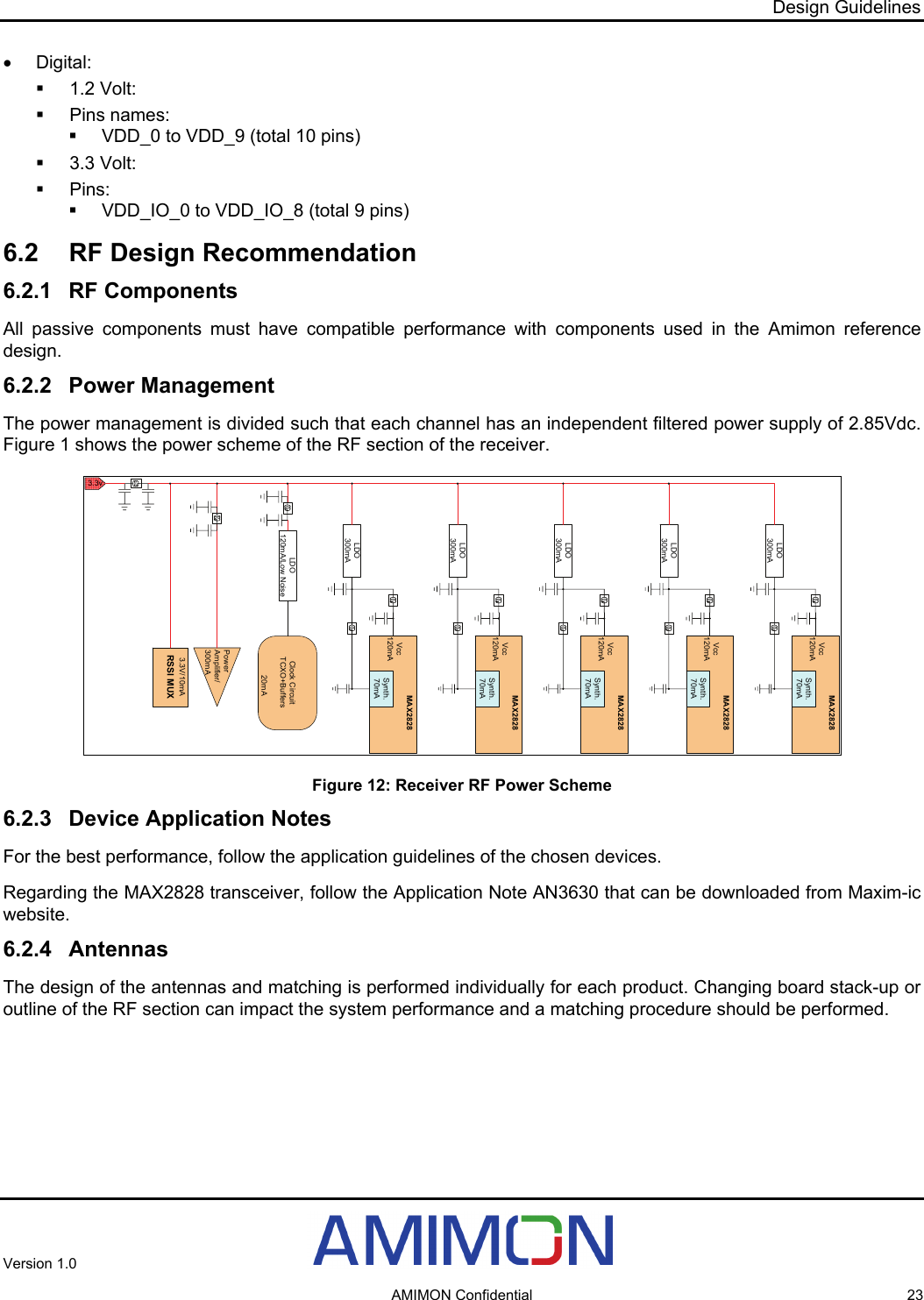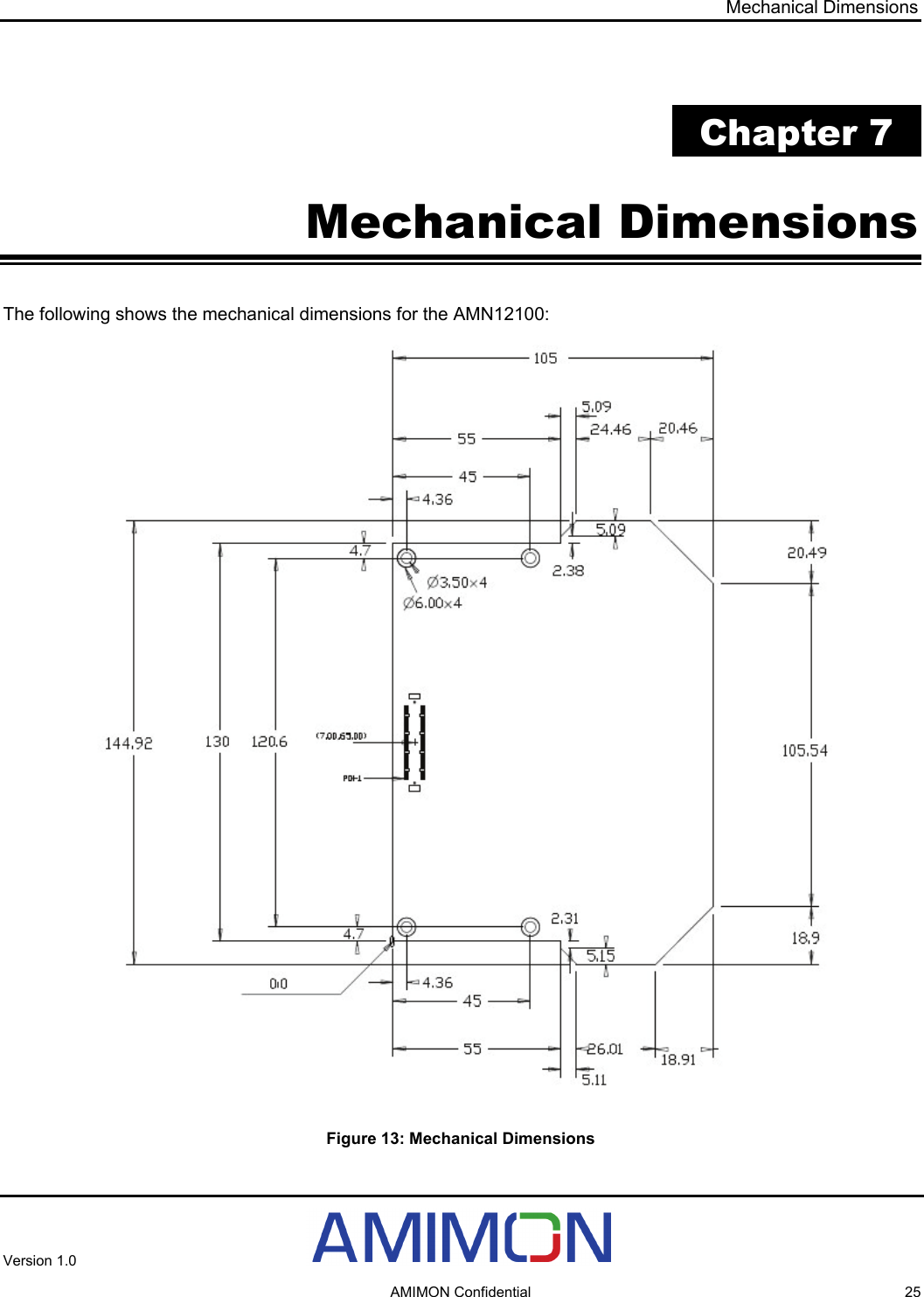Amimon AMN12100R44 AMN12100 Receiver - WHDI Wireless Modules User Manual AMN12100 WHDI Receiver Data Manual
Amimon Ltd. AMN12100 Receiver - WHDI Wireless Modules AMN12100 WHDI Receiver Data Manual
Amimon >
Contents
- 1. Users Manual
- 2. User Manual
Users Manual
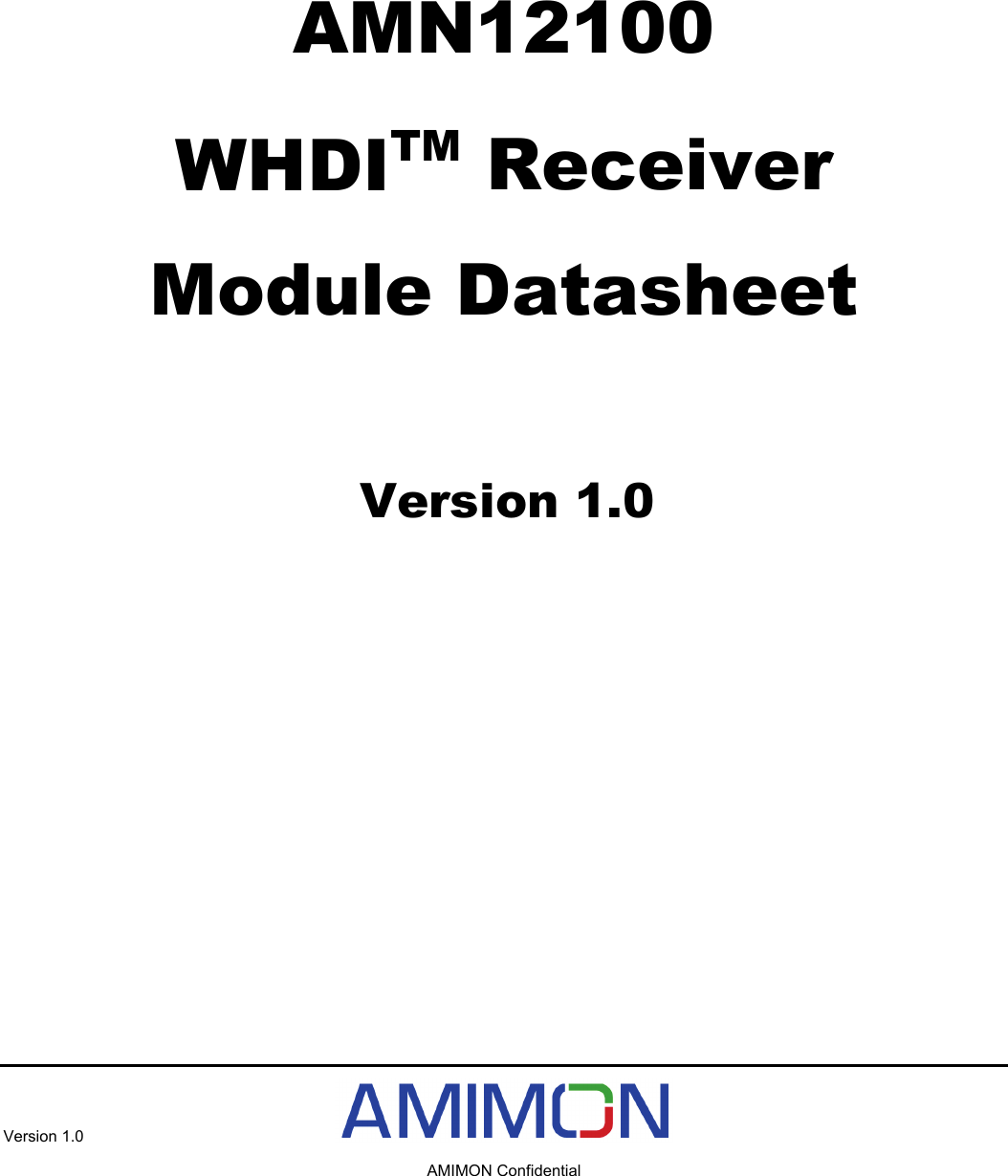

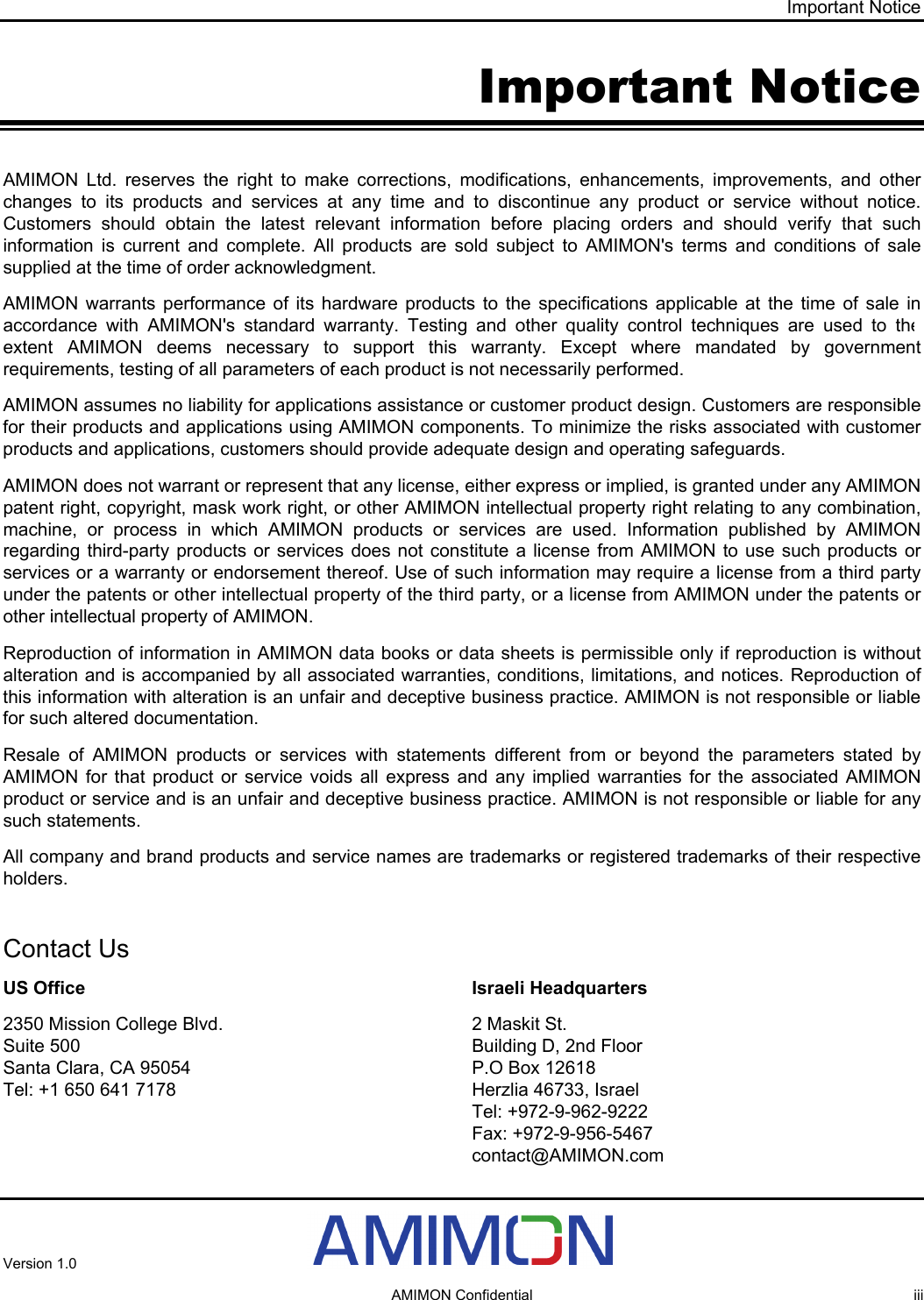
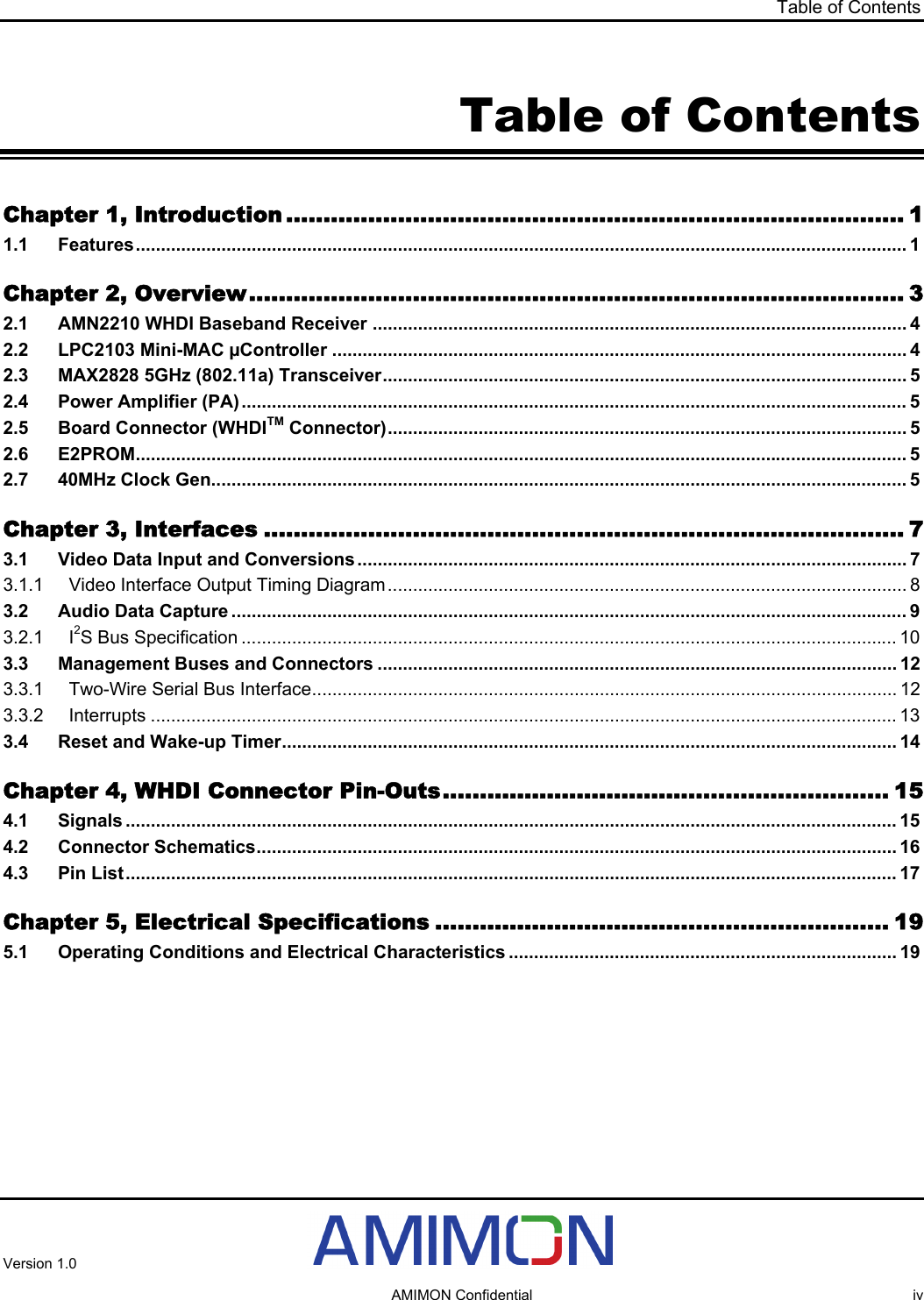
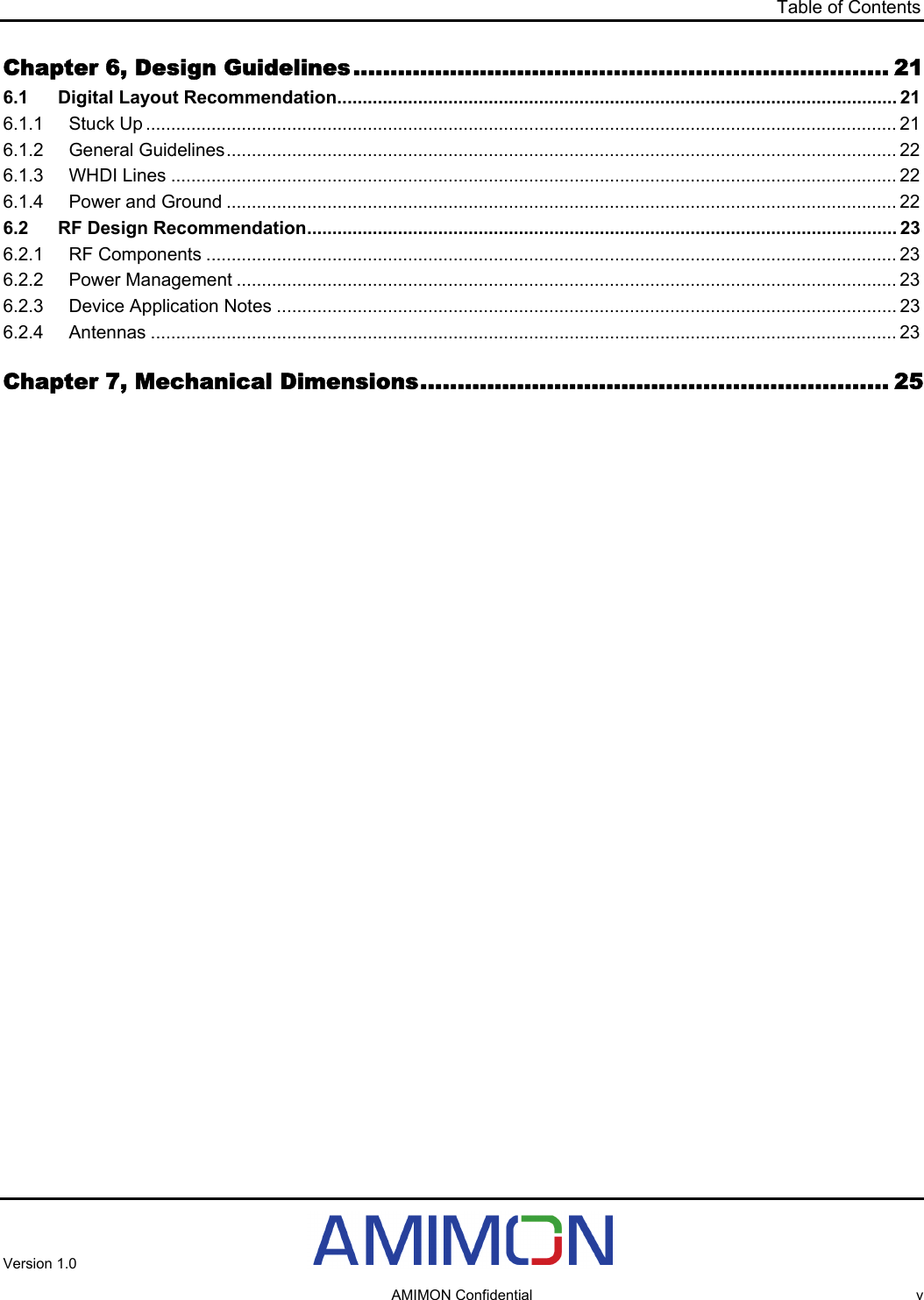
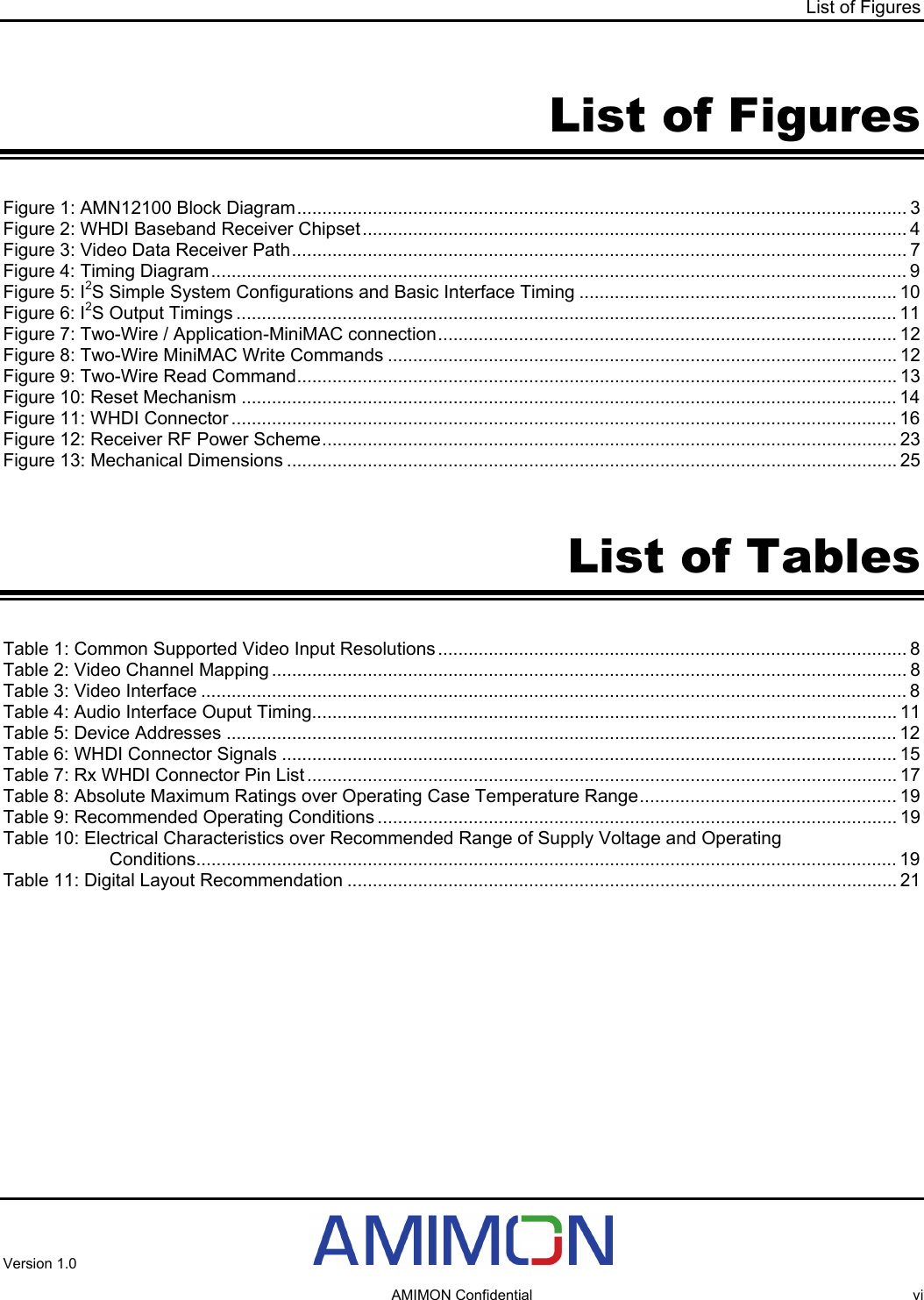
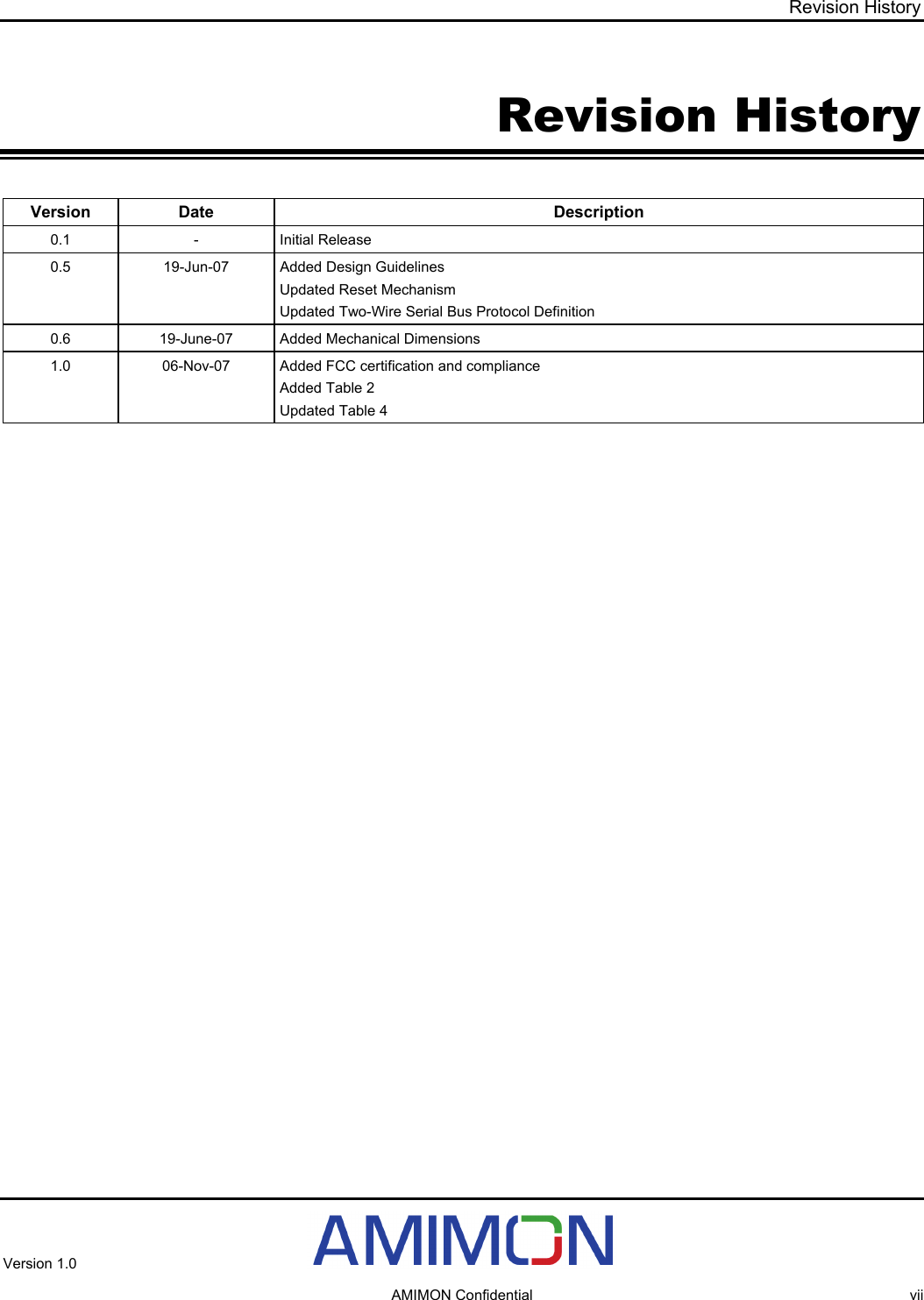

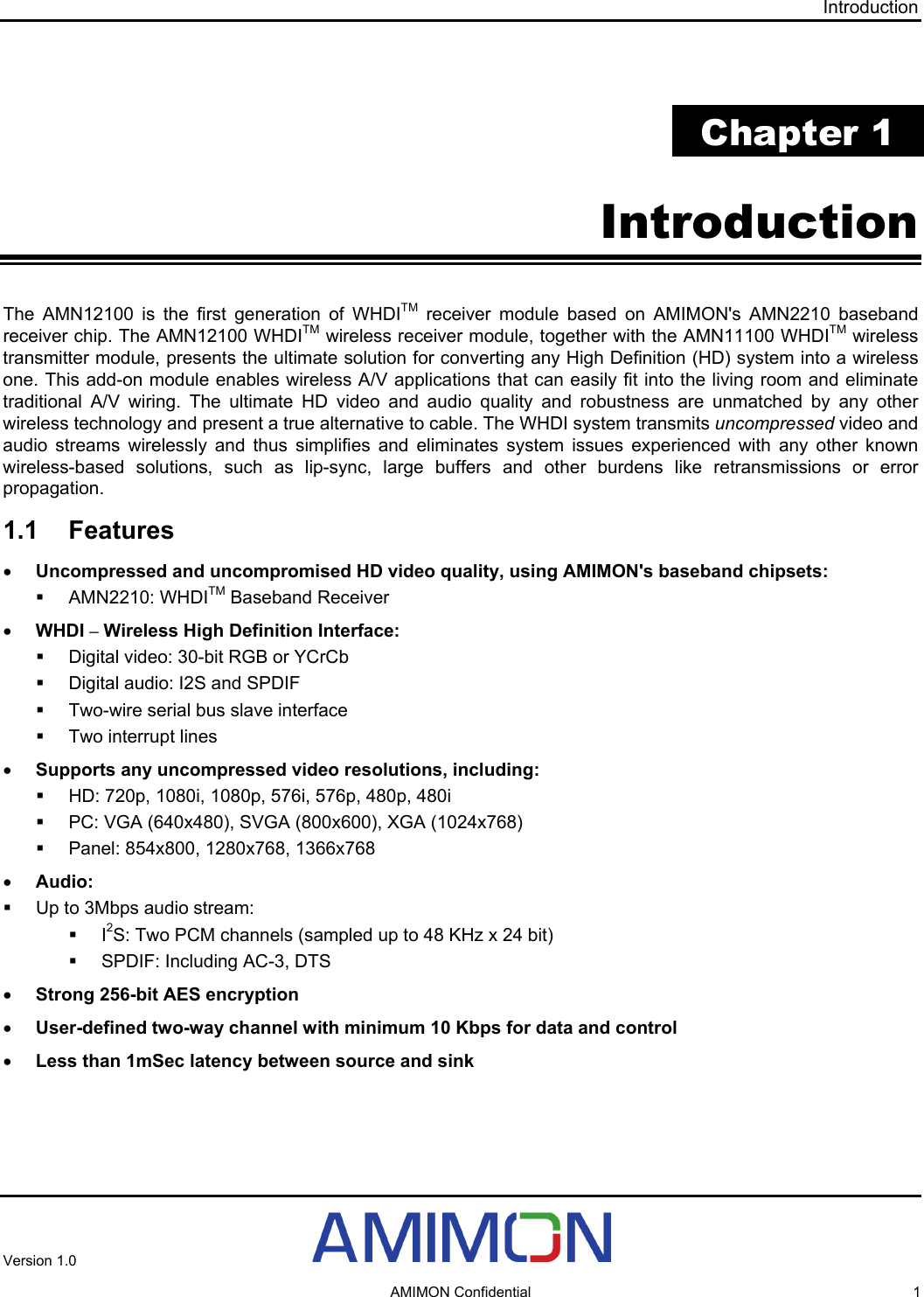
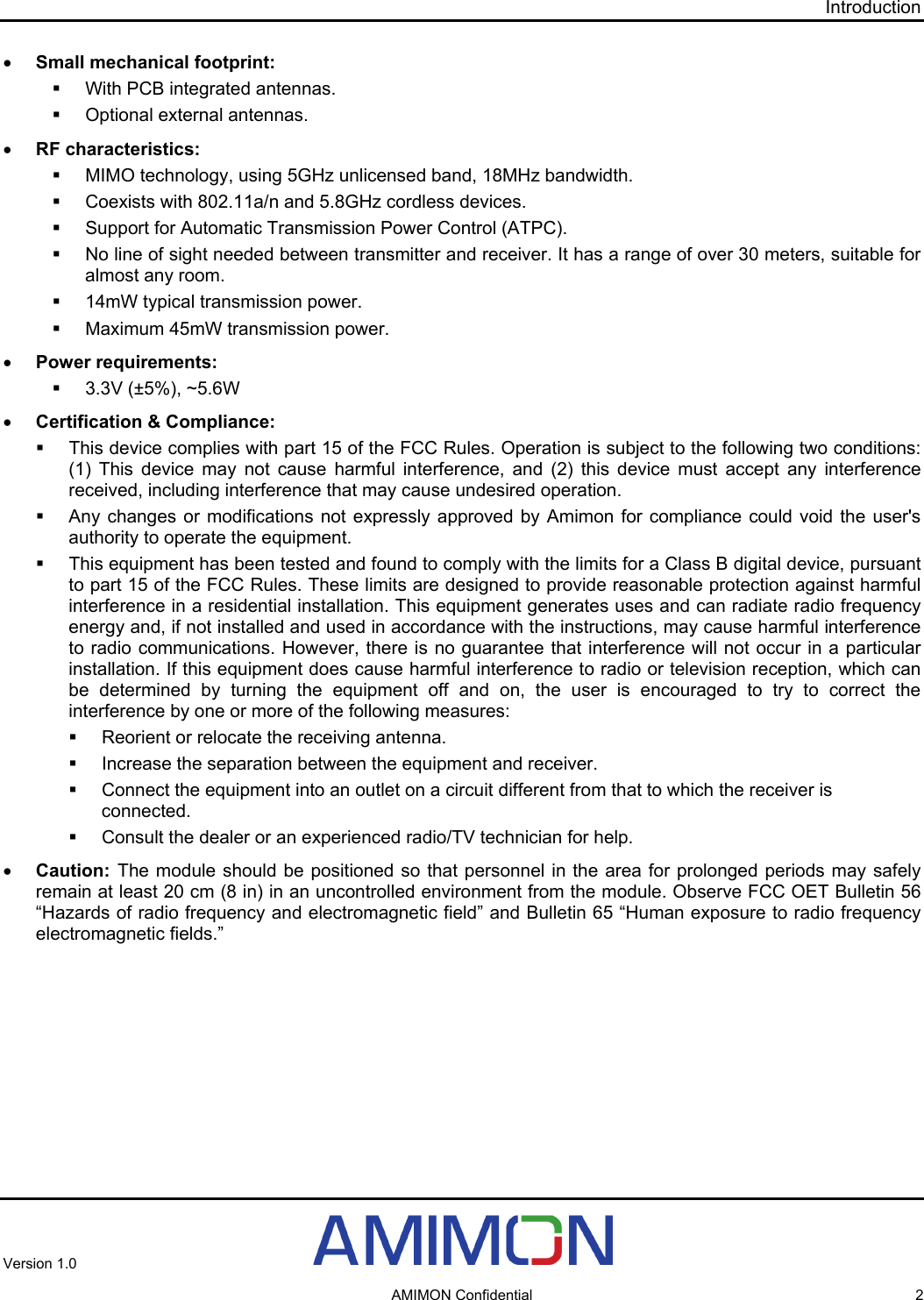
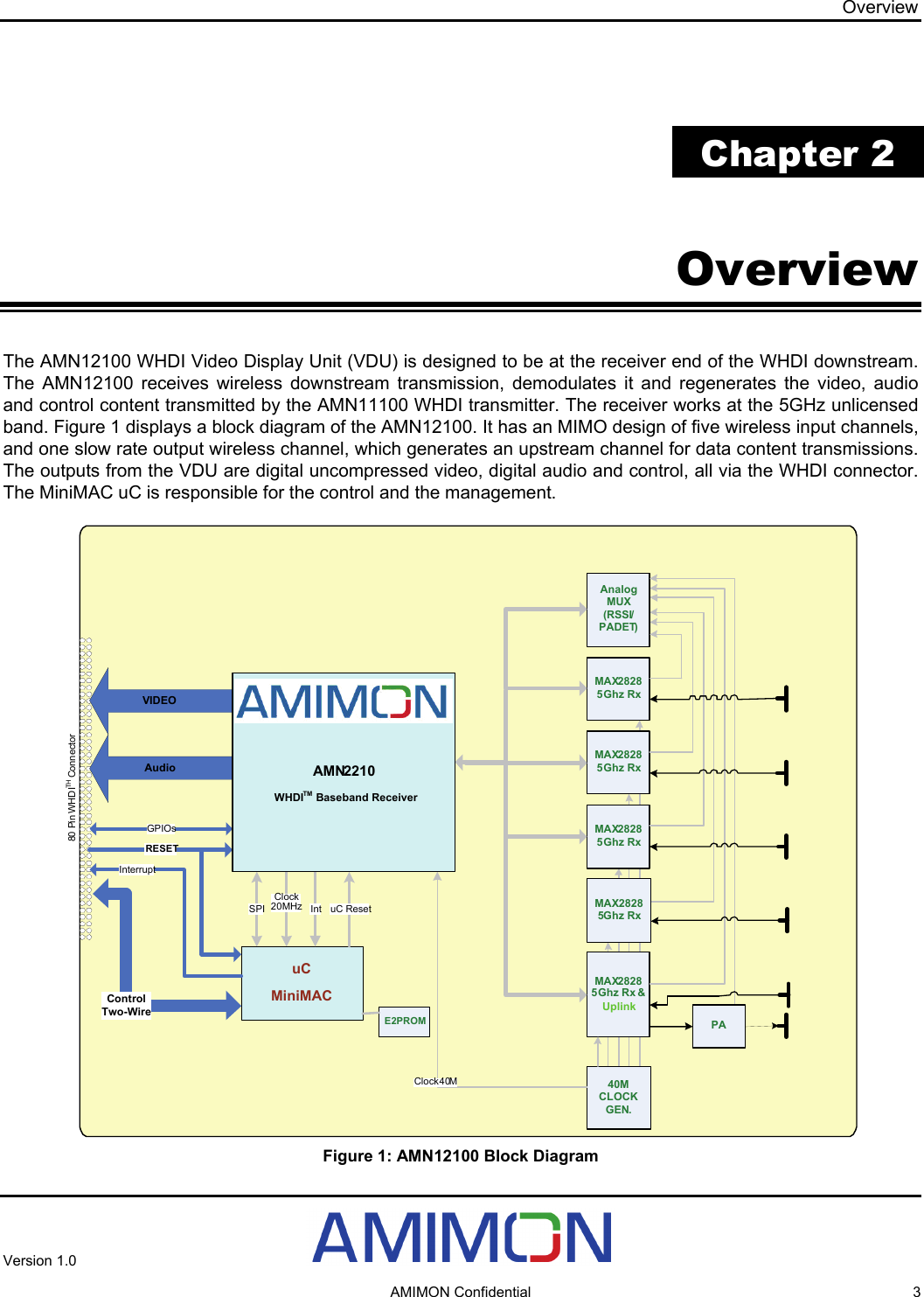
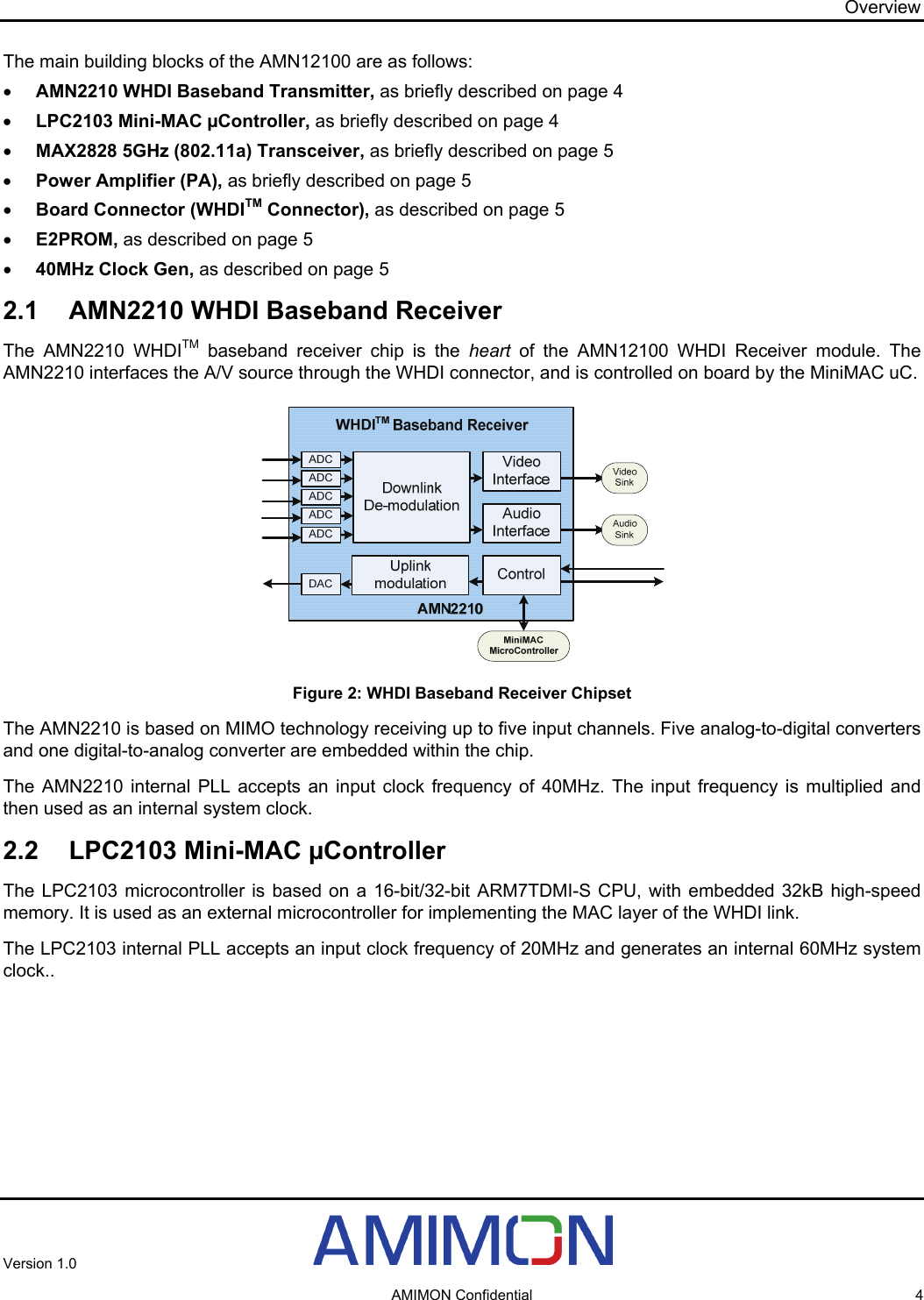
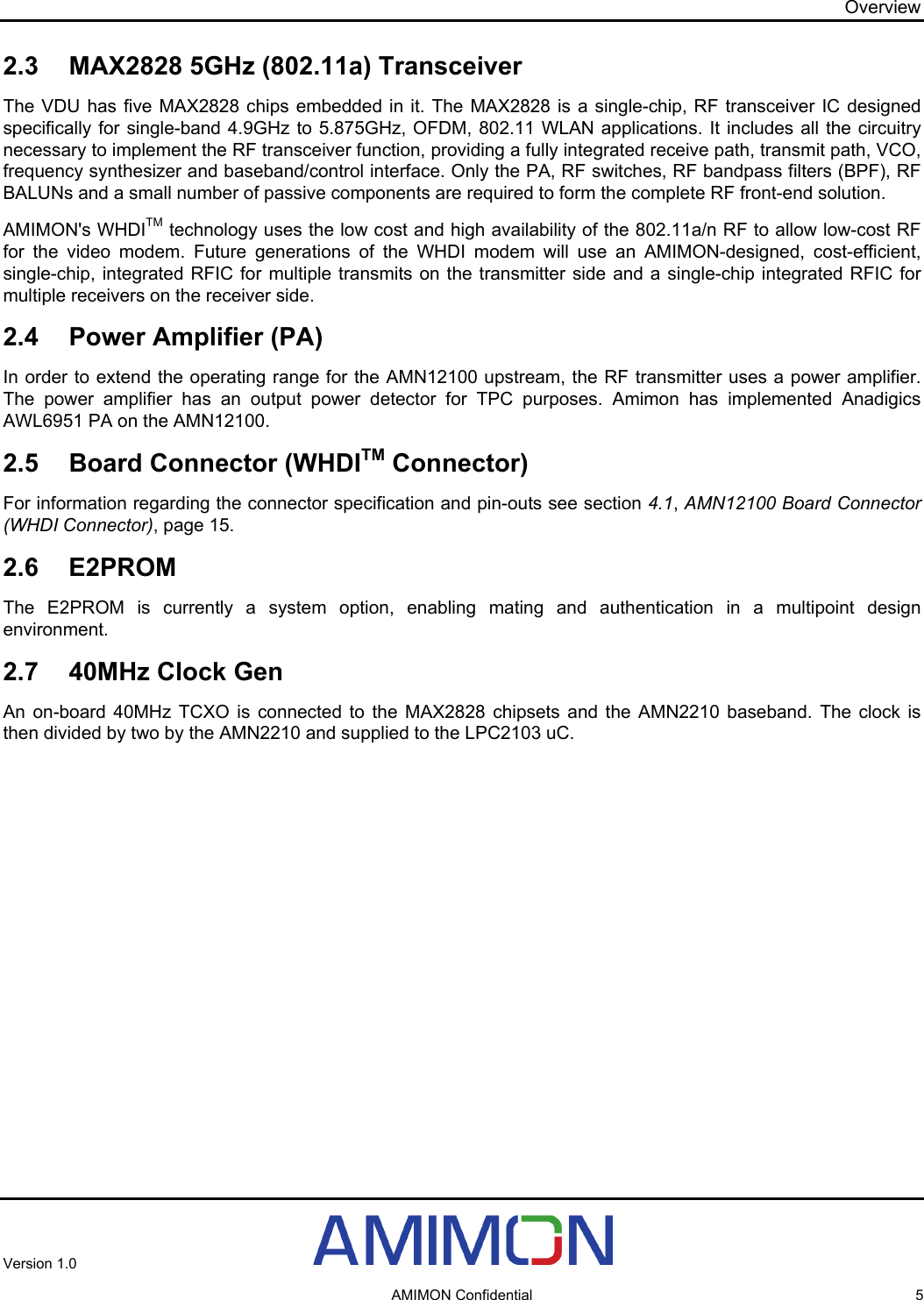

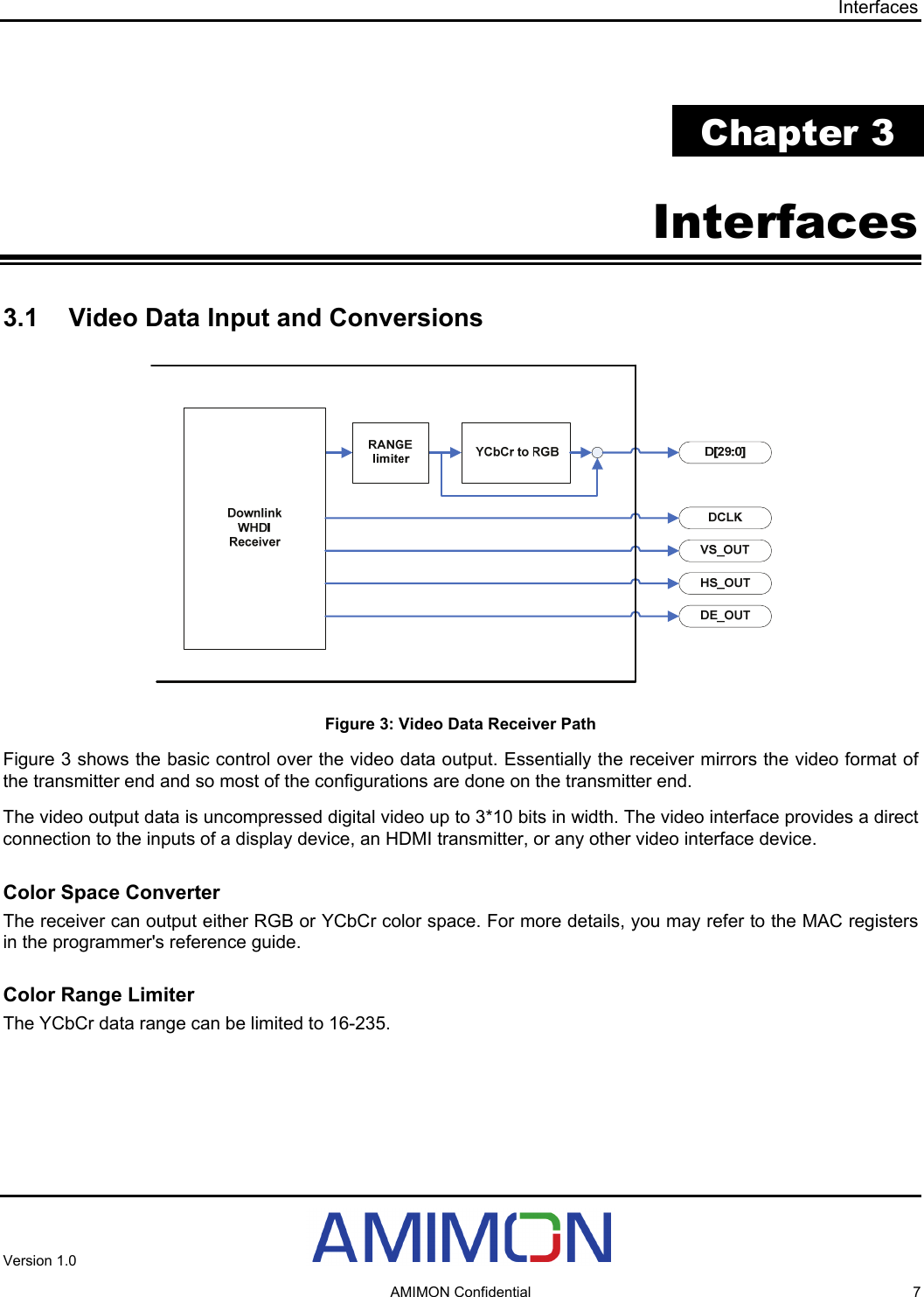
![Interfaces Common Video Output Format Table 1 lists the common supported video output resolutions. Table 1: Common Supported Video Input Resolutions Input Pixel Clock (MHz) Color Space Video Format Bus Width 480i 480p XGA 720p 1080i RGB/YCbCr 4:4:4 24 27 27 65 74.25 74.25 Video Channel Mapping The 30 bit video output signals are mapped to the RGB and YCbCr color space according to the options described in the following table: Table 2: Video Channel Mapping Option D[29:20] D[19:10] D[9:0] #1 RED (Cr) GREEN (Y) BLUE (Cb) #2 RED (Cr) BLUE (Cb) GREEN (Y) #3 GREEN (Y) RED (Cr) BLUE (Cb) #4 GREEN (Y) BLUE (Cb) RED (Cr) #5 BLUE (Cb) RED (Cr) GREEN (Y) #6 BLUE (Cb) GREEN (Y) RED (Cr) The AMN121000 allows any of the output video channels options. The first option is the default from power-up. In order to change the video channel mapping, refer to the appropriate programmer's reference guide. 3.1.1 Video Interface Output Timing Diagram 3.1.1.1 Timing Requirements Important: The following parameters relate to the AMN2210 baseband chipset and not to the entire AMN12100 board. Table 3: Video Interface Symbol Parameter MIN TYP MAX Units DCLK period 12.8 40 ns TDCKCYCCLK frequency 25 78.125DTDCKFREQ MHz TDCKDUTY DCLK duty cycle 40% 60% ns D AMIMON Confidential 8 TDCKPDR Propagation delay after CLK rising edge 1.0 4.0 ns DTDCKPDF Propagation delay after CLK falling edge 1.0 4.0 ns Version 1.0](https://usermanual.wiki/Amimon/AMN12100R44.Users-Manual/User-Guide-874428-Page-16.png)
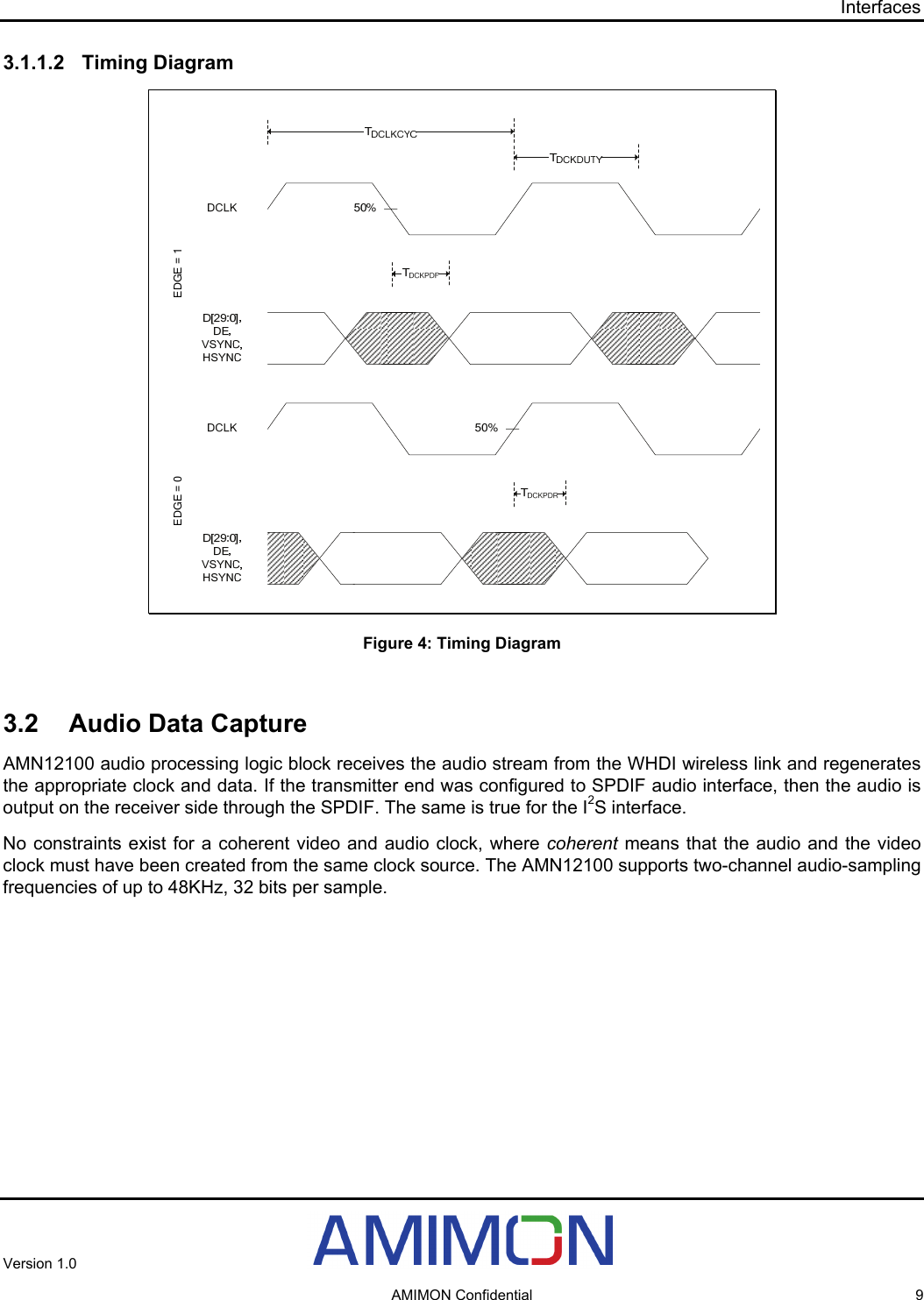
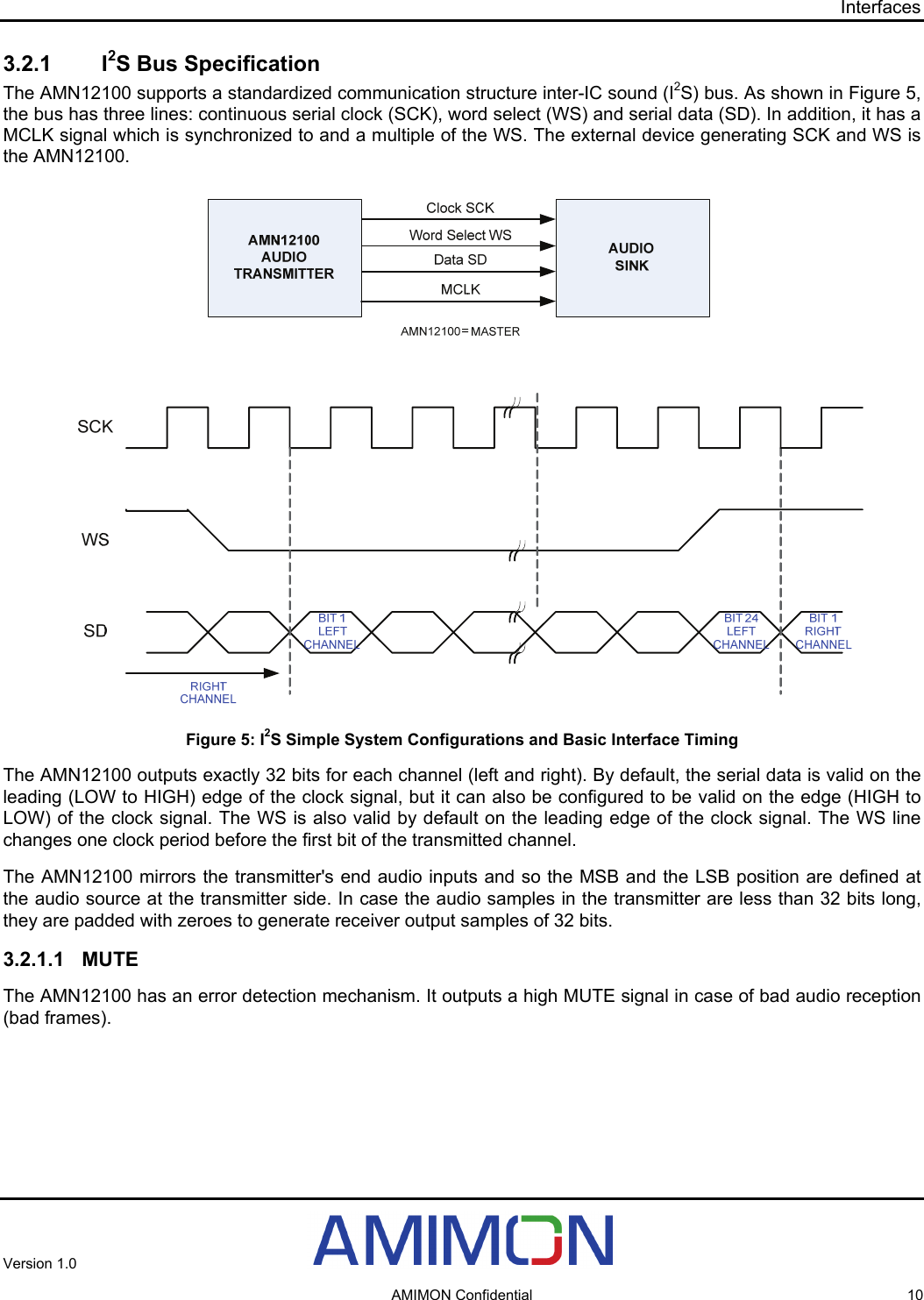
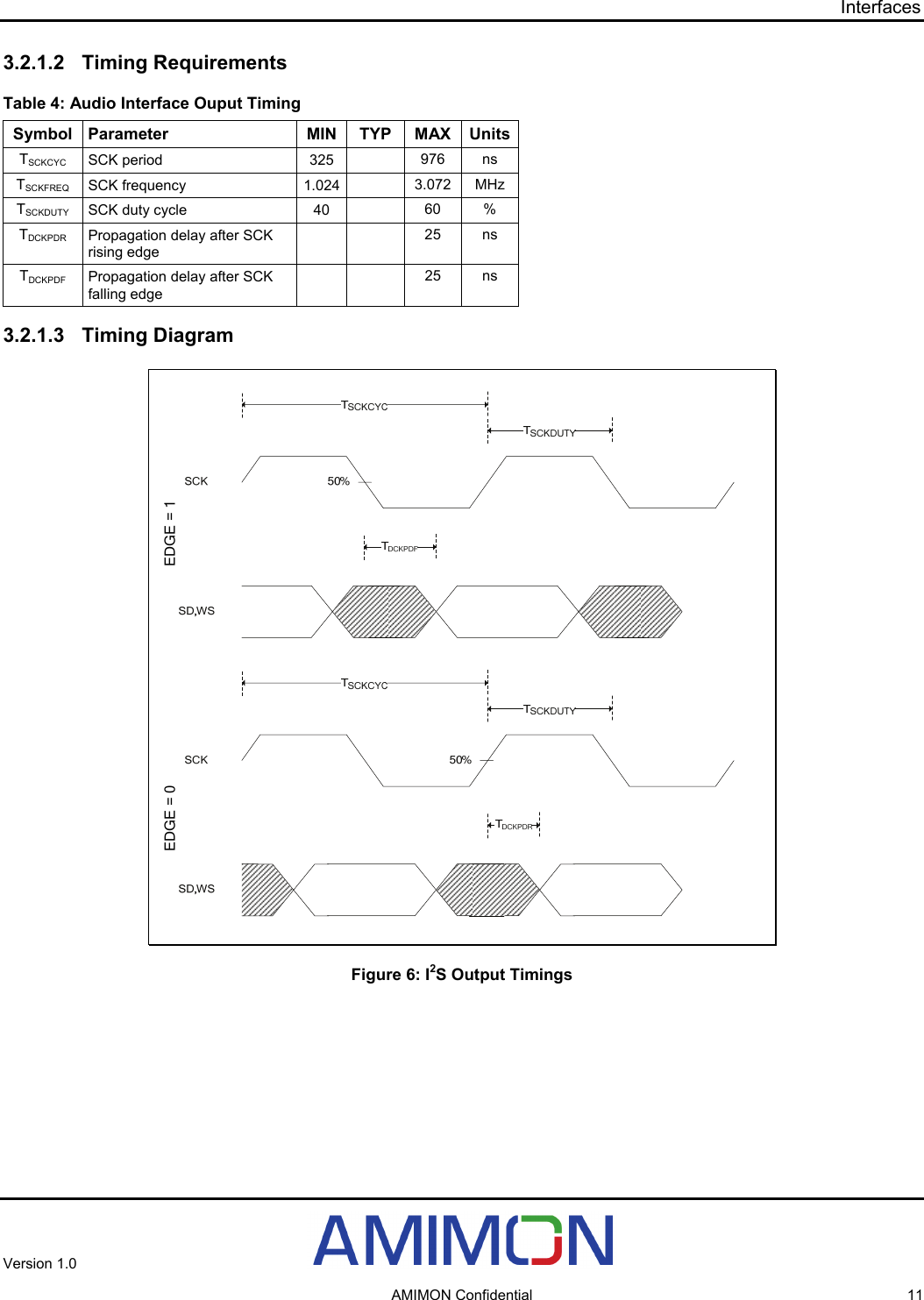
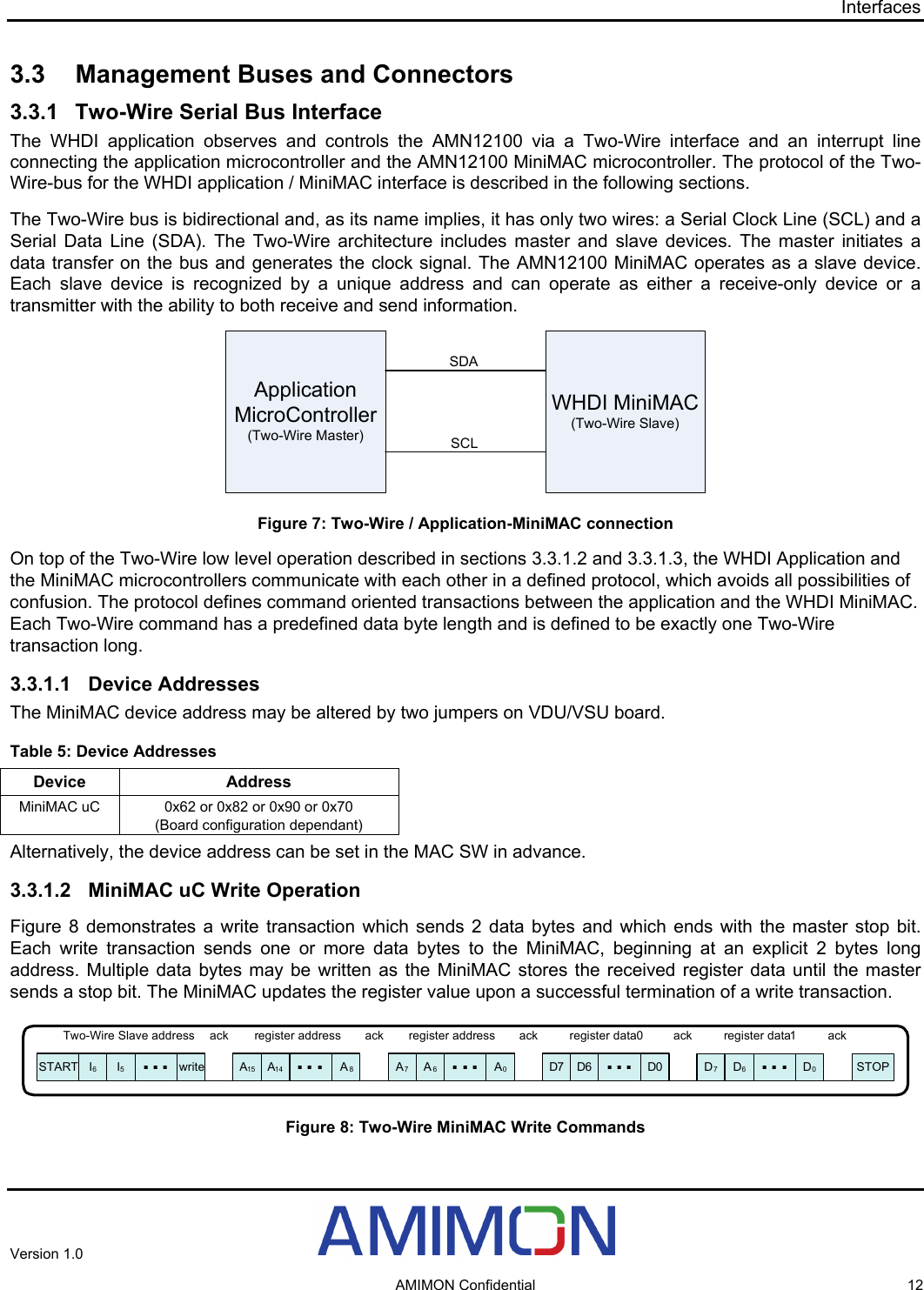
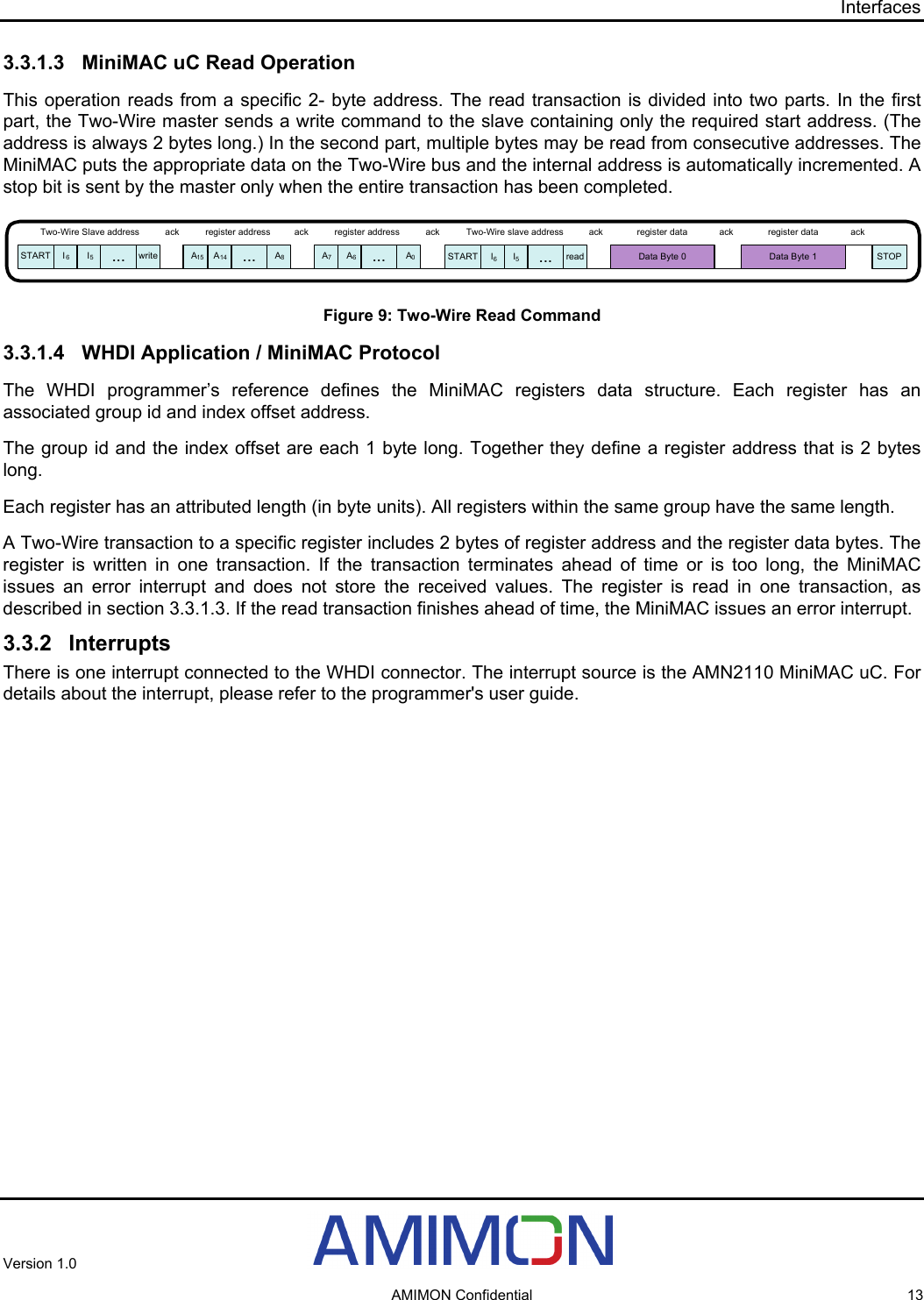
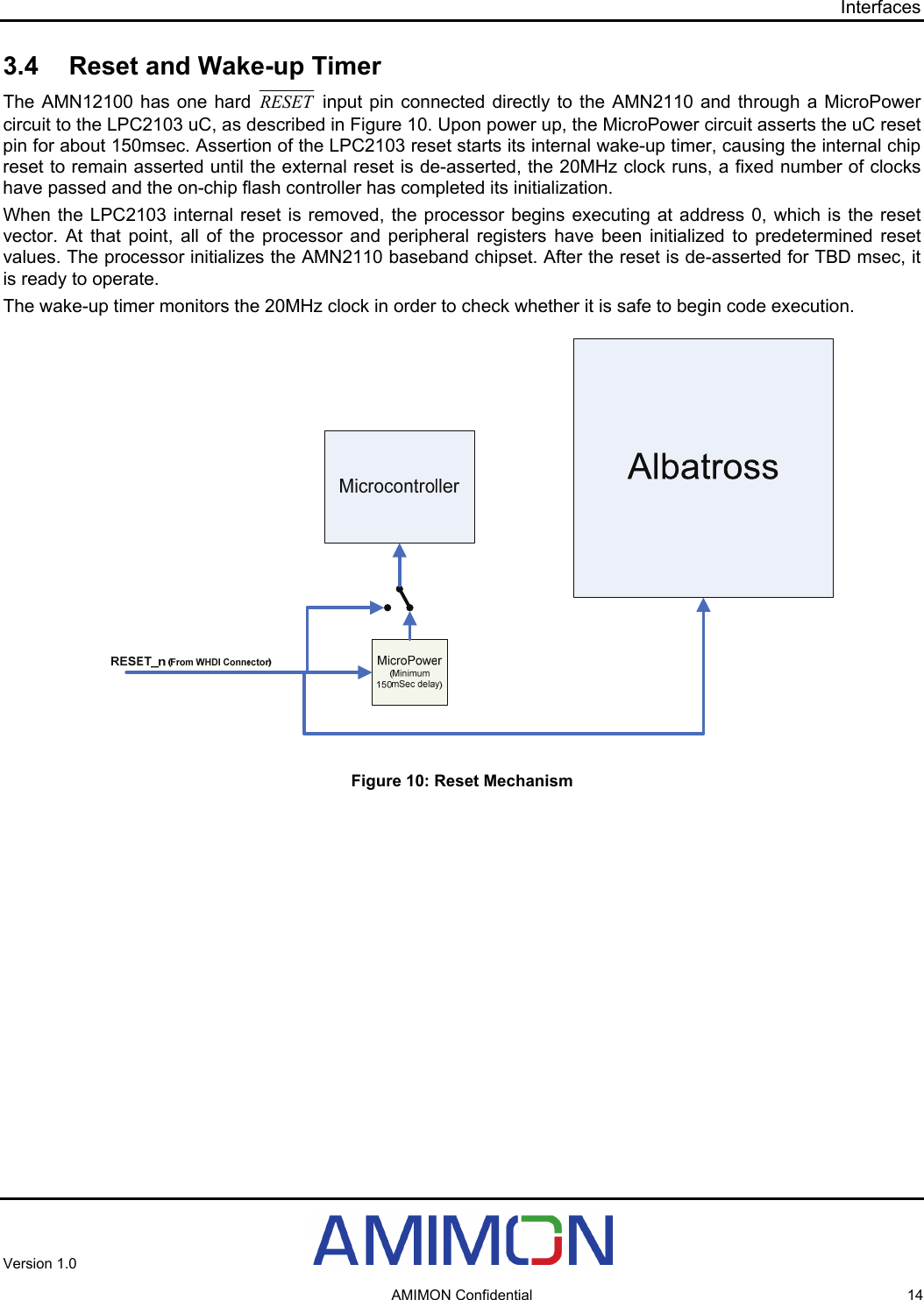
![WHDI Connector Pin-Outs Chapter 4 WHDI Connector Pin-Outs 4.1 Signals Table 6: WHDI Connector Signals # of Pins Pin Name Description / Functionality Group Direction Remarks 30 D[29:0] 30-bit RGB (10:10:10) or YCrCb (10:10:10) Video Out 1 DCLK Video data clock Video Out Up to 78.125 MHz 1 DE Data enable Video Out 1 H_SYNC Horizontal sync Video Out 1 V_SYNC Vertical sync Video Out 1 SPDIF SPDIF audio interface Audio Out 1 SD I2S audio interface Serial Data signals Audio Out 1 SCLK I2S continuous serial clock Audio Out Up to 3.072Mbps 1 WS(LRCLK) I2S Word Select (Left/right clock) which defines also the sampling rate Audio Out 1 MCLK I2S master clock coherent to WS according to specified ratio Audio Out Rate is adjustable on RX side 1 SDA Two-wire Serial Bus Data (Slave Mode) Control I/O Control I/F for WHDI 1 SCL Two-wire Serial Bus Clock (Slave Mode) Control In Control I/F for WHDI 1 INT Interrupt from WHDI module Control Out 1 RESET Reset / Power-down line Control In 1 MUTE MUTE signal Audio Out Signals audio error and can be used by the next audio device down the line to mute the audio when errors occur 6 TBD[5:0] TBD0, TBD1, TBD4, TBD5 are reserved in AMN11100, AMN12100 as an option for external power rail to the on board uC TBD TBD 8 3.3V VCC Power Power 300 mA maximum rating per pin 6 3.3V_OR_5V High Power rail pins, In AMN11100, AMN12100 connect these power rail pins to the 3.3V power rail Power Power For board designed as "High-Power" PA connect this rail to 5V, For Rx (AMN12100) connect always to 3.3V power 15 GND Ground Power Power Version 1.0 AMIMON Confidential 15](https://usermanual.wiki/Amimon/AMN12100R44.Users-Manual/User-Guide-874428-Page-23.png)
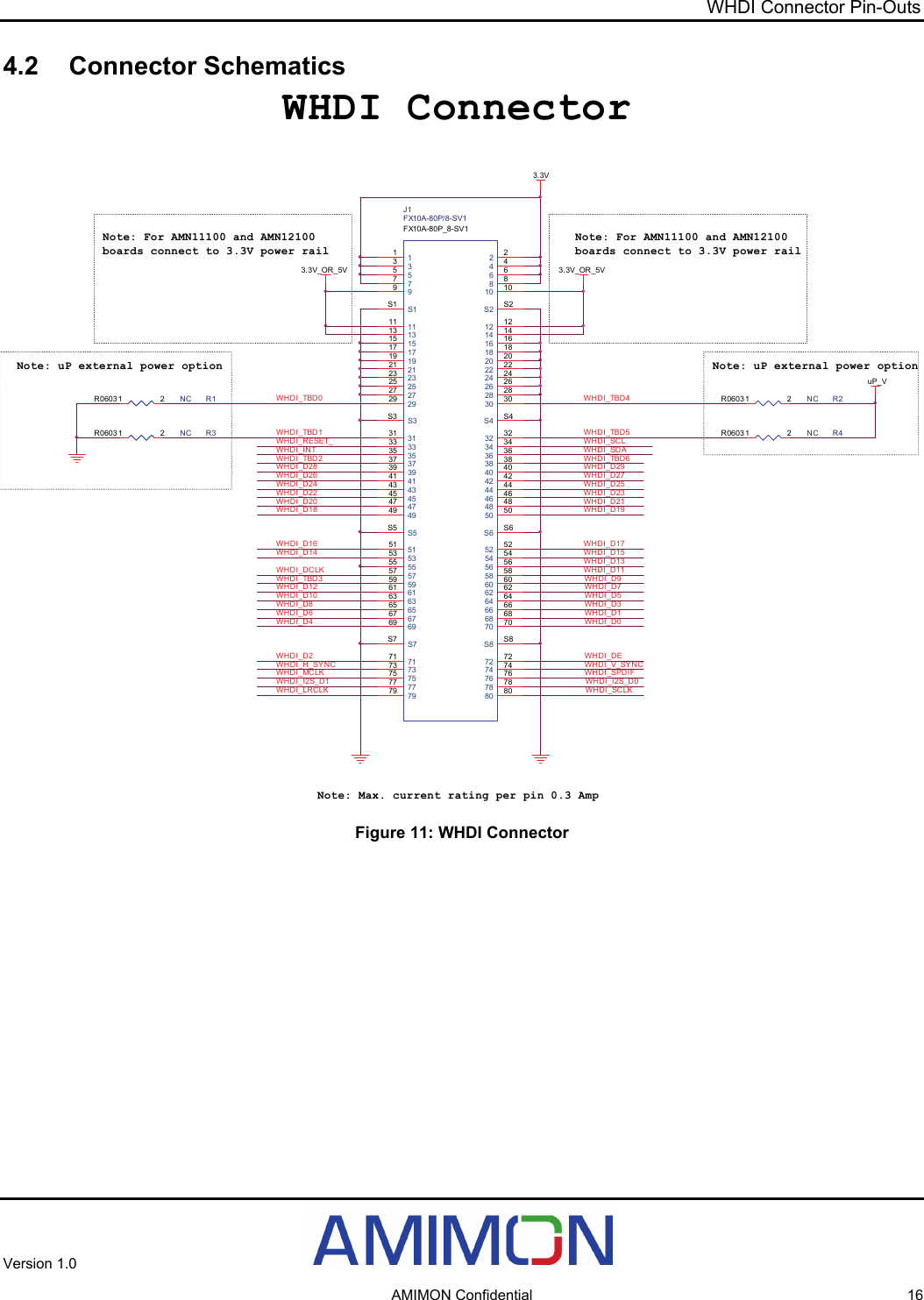
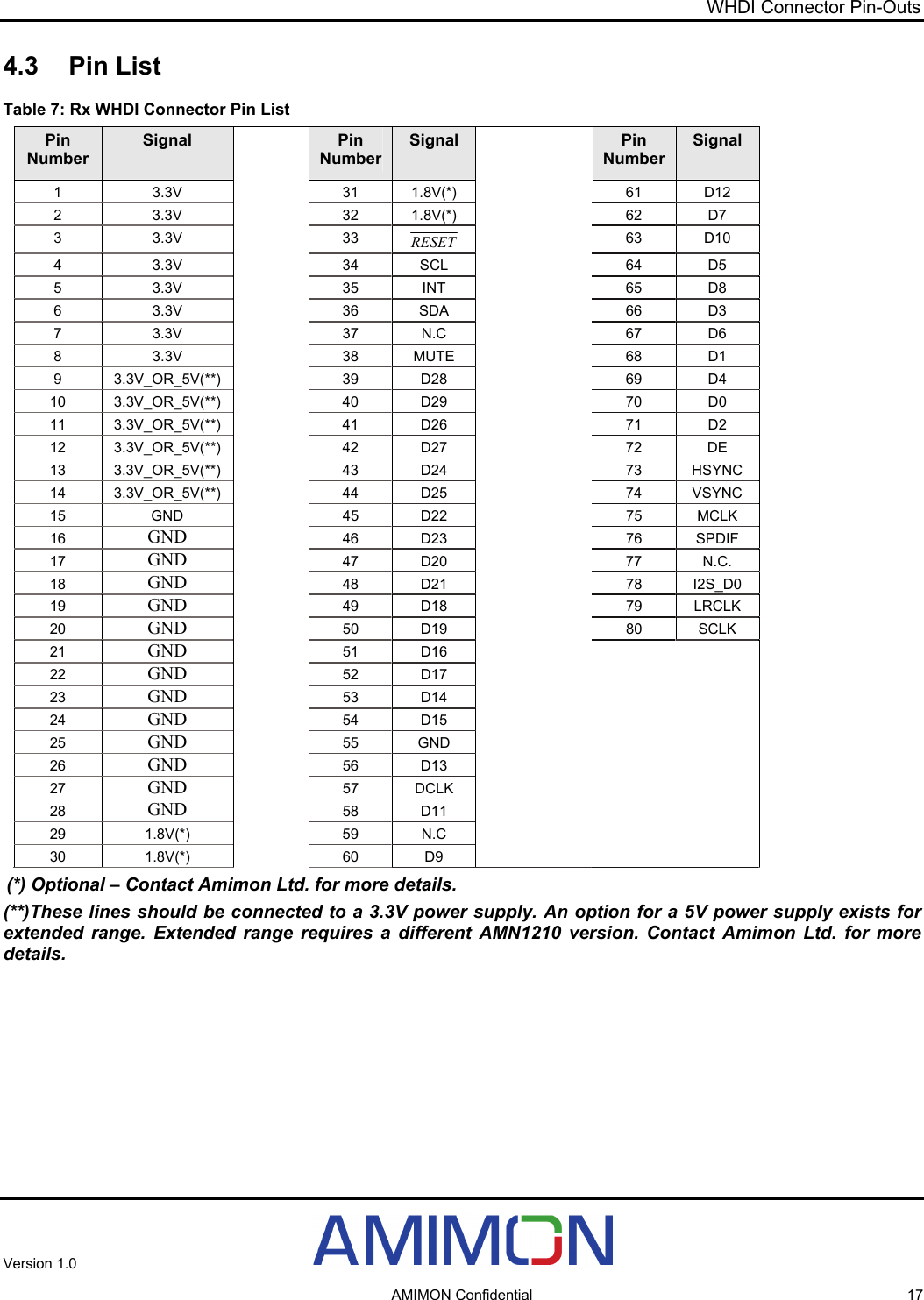
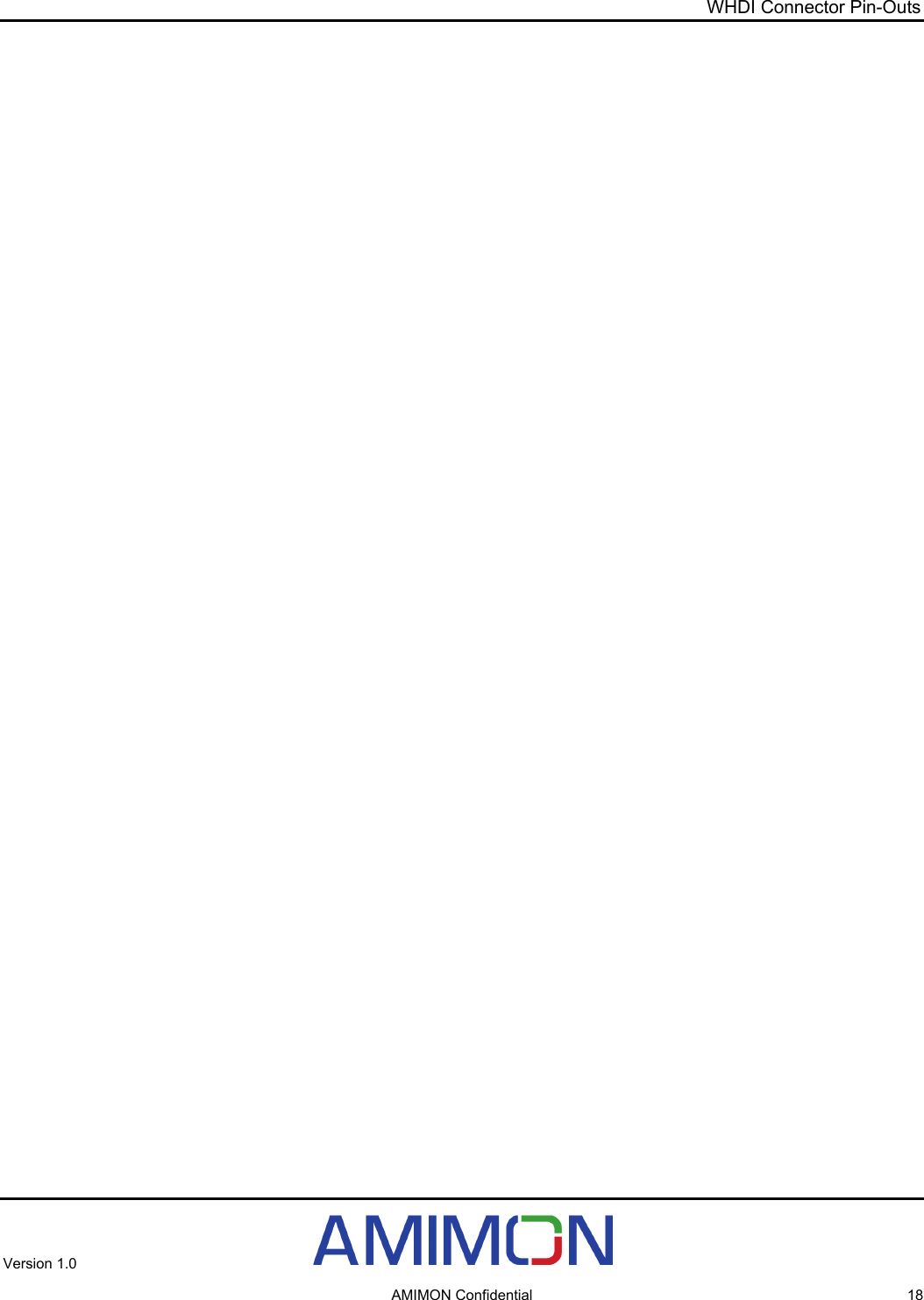
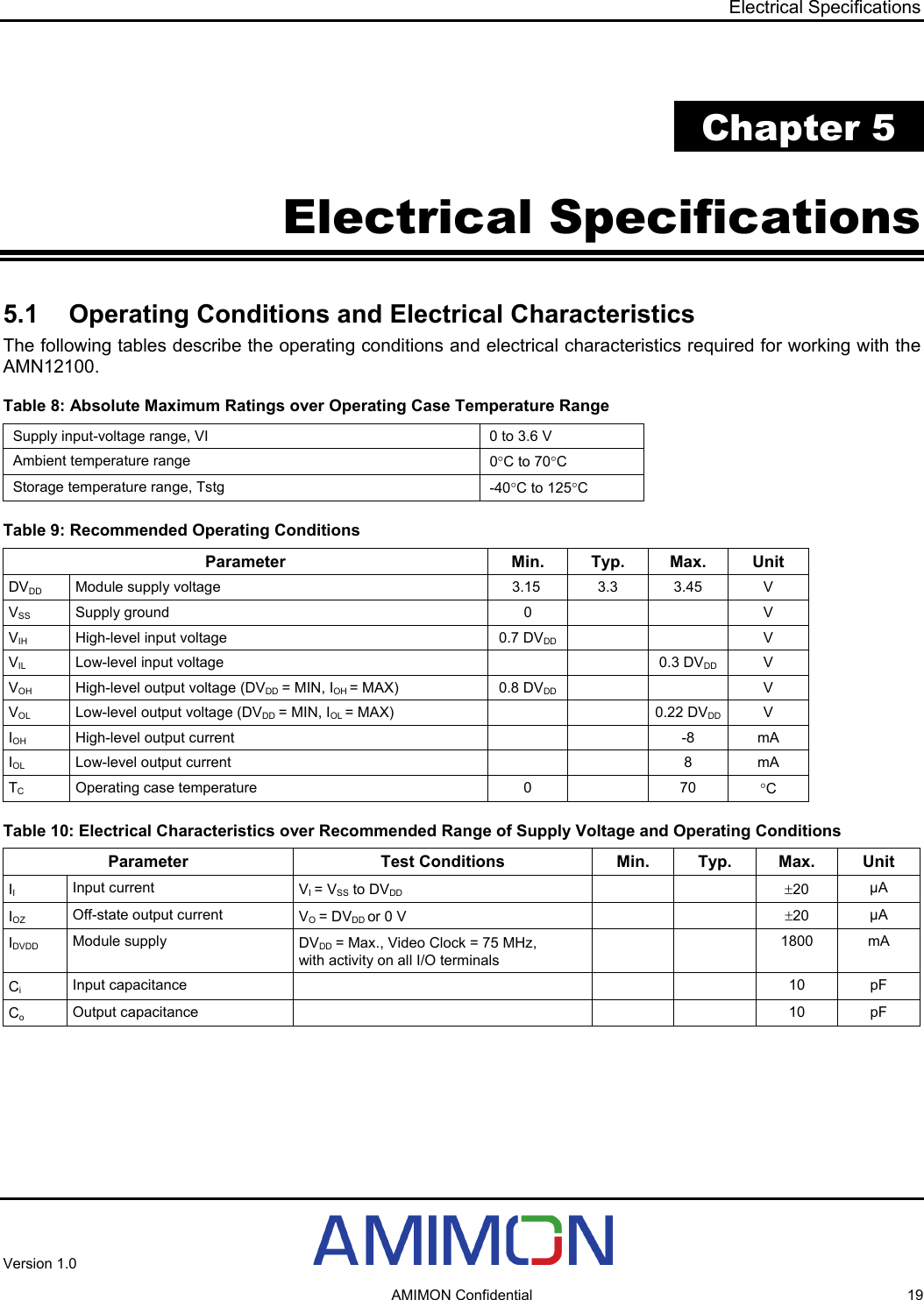

![Design Guidelines Chapter 6 Design Guidelines 6.1 Digital Layout Recommendation To better understand the layout guidelines, please refer to the AMN12100 schematics which are part of the HDK package. 6.1.1 Stuck Up Recommended stuck up for 10 layers design: • Total thickness 1.6mm • Tolerance: 10% Table 11: Digital Layout Recommendation Conductor Width [mil] Control Impedance [ohm] StuckUp Before Stripline Differential thickness Scale Required Design Before Before Layer Title Des. Oz/mil Layer line space line space Required Design Required Design Type No Cu 0.5 Oz CS 5 0 5.25 5.25 0 0 100 100 SIG L1 Space 7 mil 15 30 14 31 0 0 50 48 Cu 0.5 Oz L2 11 0 12 0 50 50 0 0 GND L2 Space 4 mil 0 0 0 0 0 0 0 0 Cu 0.5 Oz L3 5 6 4.25 6.75 0 0 100 100 SIG L3 Space 7 mil 6 0 5 0 50 50 0 0 Cu 0.5 Oz L4 0 0 0 0 0 0 0 0 GND L4 Space 4 mil 0 0 0 0 0 0 0 0 Cu 0.5 Oz L5 0 0 0 0 0 0 0 0 VCC L5 Space 9 mil 0 0 0 0 0 0 0 0 Cu 0.5 Oz L6 5 6 4.5 6.5 0 0 100 100 SIG L6 Space 4 mil 6 0 5.5 0 50 50 0 0 Cu 0.5 Oz L7 0 0 0 0 0 0 0 0 GND L7 Space 7 mil 0 0 0 0 0 0 0 0 Cu 0.5 Oz L8 5 6 4.25 6.75 0 0 100 100 SIG L8 Space 4 mil 6 0 5 0 50 50 0 0 Cu 0.5 Oz L9 11 0 12 0 50 50 0 0 GND L9 Space 7 mil 15 30 14 31 0 0 50 48 Cu 0.5 Oz PS 5 0 5.25 5.25 0 0 100 100 SIG L10 Version 1.0 AMIMON Confidential 21](https://usermanual.wiki/Amimon/AMN12100R44.Users-Manual/User-Guide-874428-Page-29.png)
